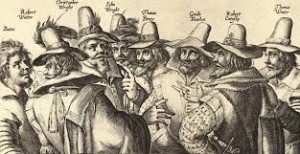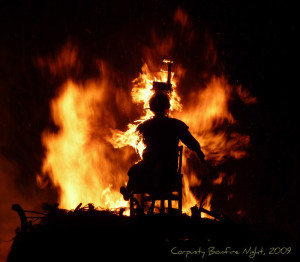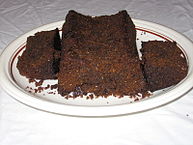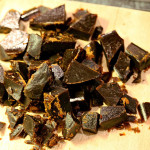Now that Halloween is behind us, I thought that it would be fun to introduce you, gentle reader, to a very British autumnal celebration – Bonfire Night (aka Guy Fawkes Night).
Every year on November 5th, bonfires are lit – from small backyards to large community affairs – and fireworks set off, to commemorate an unlucky would-be terrorist and his part in The Gunpowder Plot of 1605.
“Whaat?” I hear my non-British friends cry, “Explain please!”
Oh, all right then! Sit back, grab a hot cocoa, and brace yourselves for a story of infamy, betrayal and deceit.
In 1534, Pope Clement VII refused to grant Henry VIII the divorce which would have allowed him to marry Anne Boleyn. In retaliation, England broke away from the Catholic church. Subsequently, anyone who continued to follow the “Church of Rome” was treated with suspicion and fear. It was widely believed, (not always without cause), that Catholics’ main allegiance was to the Pope and not their monarch, and therefore liable at any time to stage a foreign-led revolt. As a result, Catholics found themselves the focus of extreme oppression.
In revenge for decades of persecution by the Protestant government, a group of prominent English Catholics conspired to remove James I and his ministers during the opening of Parliament on November 5, 1605. They concluded that the best way to do this was to place a large amount of gunpowder in the cellars of the Houses of Parliament and blow everyone up. Among the conspirators, was one Guido (Guy) Fawkes, a mercenary who had fought for England’s arch-enemy Spain, and had a knowledge of explosives.
Unfortunately for Fawkes, an anonymous tip-off alerted the authorities, and he was caught red-handed setting up barrels of gunpowder in one of the cellars. He was immediately arrested. Under torture, he revealed the names of his fellow conspirators, all of whom were eventually killed, or captured and executed.
Not long afterwards, in commemoration of the plot’s failure, King James declared that November 5 would be a public holiday. Over the years, the ritual of burning a “guy” – a representation of Guy Fawkes, developed, which, as far as I know, still occurs today. Children would create scarecrow-like effigies and parade them around town shouting “Penny for the Guy!” as a way of earning money, before the “guy” was placed atop the bonfire. I remember kids doing this back in the day. I may have been one of those kids.
Like every holiday, Bonfire Night has its own particular yummy treats! My mom would make parkin ( a delicious dark gingerbread) and we would also have treacle toffee, or “bonfire toffee” as some call it. Both treats rely heavily on spices and the dark yumminess of molasses or black treacle.
So, if you’re ever in the UK during early November, don’t be surprised to hear the crash-bang of fireworks and the crackle of roaring bonfires, it is all in memory of Guy Fawkes – quite literally, a guy in the wrong place at the wrong time.











